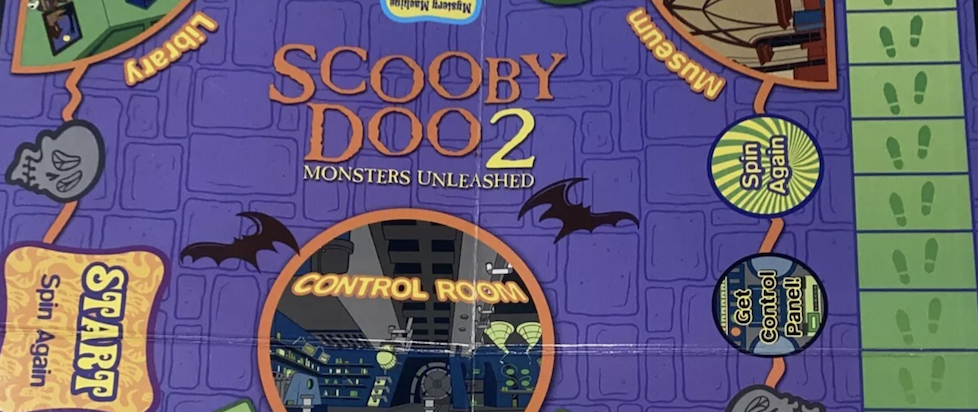
The Monster Race: Simple Times with the Scooby-Doo 2: Monsters Unleashed Game
I see board games in the store and they always look so cool and then I buy them and bring them home, I’m so excited to open them, and then I play them, like, twice… This column is dedicated to the love of games for those of us whose eyes may be bigger than our stomachs when it comes to playing, and the joy that we can all take from games, even if we don’t play them very often.
———
Since I started this column, I have done several installments covering various Scooby-Doo-themed board games. The Scooby-Doo 2: Monsters Unleashed Game is something different, though. Not just a Scooby-Doo board game, it is specifically a tie-in to the second live-action Scooby-Doo film, released by Pressman Toy Company in 2005 and by now long out of print because, really, who keeps a movie tie-in game in print for very long after the movie has come and gone?
It’s also very different from what we usually cover here for other reasons. It’s cheaply made, for starters, and almost painfully simple. Little more than a standard “spin and move” game, Scooby-Doo 2: Monsters Unleashed is recommended on the package for ages 6 and up, but anyone much older than 6 is probably going to quickly lose interest in the simplistic gameplay.
The instructions are printed on two sides of a single sheet of folded paper, which not only tells you how to play the game but also how to set everything up. And the rules are very simple. You spin a dial to move around the board. The goal is to collect monster tokens and a control panel token and get to the Control Room. (This is… not inaccurate to the plot of the movie, at least.)
When you spin a one or land on a control panel space, you get the control panel, even if one of the other players has it already. The only other real complication to the game’s MO comes when you encounter a monster. The monsters are hanging out in the four corners of the board, which are marked Hallway, Museum, Library, and Night Club (the locations, obviously, most inextricably linked with Scooby-Doo). When you land on a space that a monster occupies, you and the monster have a race.
The race begins by placing your standee and the monster’s on a separate race track on the side of the board. Then you check the bottom of the monster’s standee, where a randomly-placed sticker will tell whether the race takes place over one, two, or three rounds. From there, you spin the dial and see how many spaces you move, and another player does the same for the monster. Whoever has made the most progress after the prescribed number of rounds is the winner.
If the monster wins, you both go back to the corner space you came from and nothing happens. If you win, you get the monster’s token, and the monster is removed from the game. The first player to nab two such monster tokens and then get to the Control Room with the control panel wins the game. And… that’s about it.

One should probably not expect a lot from a quickie tie-in to the second live-action Scooby-Doo movie. Even the box of the Scooby-Doo 2: Monsters Unleashed Game is of cheap construction. And to say that there’s very little replay value in the game’s exceedingly simple mechanics is beating a dead horse.
There are some surprises in Scooby-Doo 2: Monsters Unleashed, though. For starters, the game does at least boast a lot of monsters, all represented by thin paperboard standees depicting their iterations from the film. In most cases, this is a clip-art version of their wax figures from the Coolsonian Criminology Museum displays, for those who know the movie at all. (It’s been a while since I saw Scooby-Doo 2, but there are definitely a couple in here that I didn’t remember.)
Similarly, the player standees are simply depictions of the Mystery Inc. gang as they appear in the movie. Here’s where the other surprise comes in, though. With virtually all of the other art assets in the game being stills from the movie, one would expect the board to follow suit, but it doesn’t. Instead, the board has cartoon-style art reminiscent of (though not identical to) the original animated series.
Besides the four location-based monster squares and the Control Room, the board is decorated with bats and the spaces where the players move are mostly wobbly skulls with somewhat inexplicable peace symbol eyes.
None of this is enough to make the game particularly interesting for anyone but hardcore Scooby-Doo collectors, however, and even they probably have better things to look out for, given how massively the talking dog and his teenage friends have been merchandized over the years.
When it comes to comparing the Scooby-Doo 2: Monsters Unleashed Game to any of the other Scooby-Doo games we’ve covered here, there’s really no comparison at all. Scooby-Doo 2 is the cheapest (in terms of production) and simplest of all the games that we’ve ever discussed on this column, Scooby-Doo or otherwise, and boasts precious little besides that cheapness to help it stand out.
It probably had a commensurately modest price tag when it was new, and might have been a good game for young kids who were fans of the film. These days, though, you’d have to buy it off eBay or some other second-party seller, or stumble across it at a thrift store, like I did. ——— Orrin Grey is a writer, editor, game designer, and amateur film scholar who loves to write about monsters, movies, and monster movies. He’s the author of several spooky books, including How to See Ghosts & Other Figments. You can find him online at orringrey.com.





